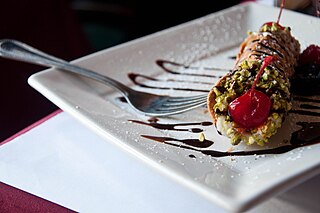
Cannoli are Sicilian pastries consisting of a tube-shaped shell of fried pastry dough, filled with a sweet, creamy filling containing ricotta cheese. Their size ranges from 9 to 20 centimetres. They have since spread to mainland Italy, where they are known as cannolo siciliano.

Sicilian cuisine is the style of cooking on the island of Sicily. It shows traces of all cultures that have existed on the island of Sicily over the last two millennia. Although its cuisine has much in common with Italian cuisine, Sicilian food also has Greek, Spanish, Jewish, Maghrebi, and Arab influences.

Frutta martorana is a Sicilian marzipan sweet in the form of fruits and vegetables from the provinces of Palermo and Trapani.

Zeppole, in Sardinia italianized zippole or zeppole sarde from the original Sardinian tzípulas, are Italian pastries consisting of a deep-fried dough ball of varying size but typically about 4 inches (10 cm) in diameter. These fritters are usually topped with powdered sugar, and may be filled with custard, jelly, cannoli-style pastry cream or a butter-and-honey mixture. The consistency ranges from light and puffy, to bread- or pasta-like. They are eaten to celebrate Saint Joseph's Day, which is a Catholic feast day.
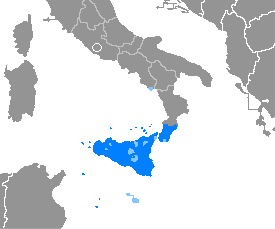
Sicilian is a Romance language that is spoken on the island of Sicily and its satellite islands. It belongs to the broader Extreme Southern Italian language group.
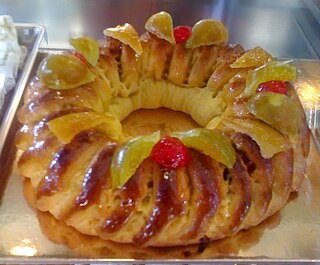
A buccellato is a Sicilian circular cake made from pastry dough filled with figs and nuts. In Sicily, it is traditionally associated with Christmas.
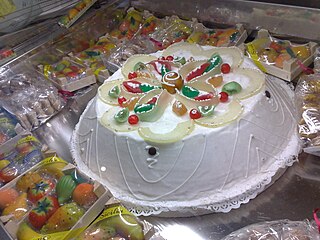
Cassata or cassata siciliana is an Italian cake originating in the Sicily region. It is typically composed of a round sponge cake moistened with fruit juices or liqueur and layered with ricotta cheese and candied fruit. It has a shell of marzipan, pink and green colored icing, and decorative designs. Cassata may also refer to a Neapolitan ice cream containing candied or dried fruit and nuts.

Crostata is an Italian baked tart or pie. The earliest known use of crostata in its modern sense can be traced to the cookbooks Libro de Arte Coquinaria by Martino da Como, published c. 1465, and Cuoco napolitano, published in the late 15th century, containing a recipe titled Crostata de Caso, Pane, etc..

The cuisine of Sardinia is the traditional cuisine of the island of Sardinia, and the expression of its culinary art. It is characterised by its own variety and by the fact of having been enriched through a number of interactions with the other Mediterranean cultures while retaining its own identity. Sardinia's food culture is strictly divided into food from the land and food from the sea, reflecting the island's historical vicissitudes and especially its geographic landscapes, spacing from the coastline to the ragged mountains of the interior. The Sardinian cuisine is considered part of the Mediterranean diet, a nutritional model that was proclaimed by UNESCO as an intangible cultural heritage.

Roman cuisine consists of the cooking traditions and practices of the Italian city of Rome. It features fresh, seasonal and simply-prepared ingredients from the Roman Campagna. These include peas, globe artichokes and fava beans, shellfish, milk-fed lamb and goat, and cheeses such as pecorino romano and ricotta. Olive oil is used mostly to dress raw vegetables, while strutto and fat from prosciutto are preferred for frying. The most popular sweets in Rome are small individual pastries called pasticcini, gelato and handmade chocolates and candies. Special dishes are often reserved for different days of the week; for example, gnocchi is eaten on Thursdays, baccalà on Fridays and trippa on Saturdays.

Maccu is a Sicilian soup and also a foodstuff that is prepared with dried and crushed fava beans and fennel as primary ingredients. Several dishes exist using maccu as a foodstuff, such as bruschetta al maccù and maccu di San Giuseppe, the latter of which may be served on Saint Joseph's Day in Sicily.

The gelo di melone, also known as gelo d'anguria, is a typical Sicilian dessert, traditionally prepared in Ferragosto. A jellied watermelon pudding, it is also popular for the Saint Rosalia celebrations in Palermo.

The giurgiulena, also known as giuggiulena, cubaita or cumpittu, is a traditional Christmas nougat-like candy, typical of the Sicilian cuisine and in use in a large part of Calabria.
Spongarda is a local cake originating in the comune (municipality) of Crema. The Lombardy region includes it as spongarda of Crema in the list of traditional food products.

Pasticciotto is a type of filled Italian pastry. Depending on the region, they are traditionally filled with either ricotta cheese or egg custard.
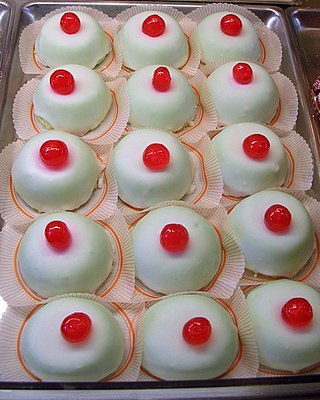
Cassatella di sant'Agata is a traditional Sicilian pastry from Catania made during the Festival of Saint Agatha, held from February 3rd to February 5th each year.
Pasta 'ncasciata is a celebratory baked pasta dish originating in the Sicilian comune (municipality) of Messina; however, today there are numerous versions from every province of Sicily and Calabria. Ingredients vary according to the region as well as personal preferences. For example, while the dish usually uses two types of cheese, béchamel sauce may be used in lieu of one of the cheeses. It was traditionally baked in a dish placed over, as well as covered by, hot coals. The dish was made more well known by Andrea Camilleri's Inspector Montalbano.
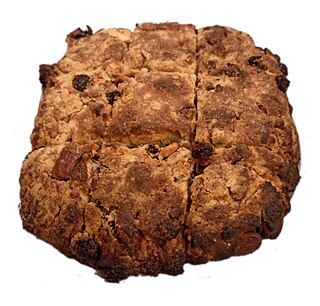
The pizza dolce di Beridde, also known as the pizza ebraica or diamanti romani, is an unleavened sweet bread associated with the city of Rome, in the Lazio region of Italy. This traditional dessert is prepared by the Roman Jewish community on the occasion of a Brit milah.
The guasteddra dolce nissena or guastedda is a typical dessert of the city of Caltanissetta tradition. The word guastedda being a cacuminal or retroflex phoneme is written guastedda and pronounced guasteddra, it is represented with the symbol [ɖ] in the international phonetic alphabet (IPA); this phoneme is not present in the Italian language.













